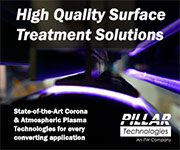Measurement technique improves metallized PP
- Published: December 01, 1995, By Stout, Tom; Sprecht, Jim; Wilhelmi, Gary
Metallized polypropylene films continue to improve, thanks in part to advancements in noncontact, quantitative surface measurement techniques.
In the snack food industry today, metallized polypropylene is generally accepted as a replacement for metallized polyester as the barrier sheet of choice for light, moisture and oxygen. Metallized polyester is still in use, but it is generally more expensive and is used primarily for applications requiring long shelf life.
Metallized PP did not attain its present-day prominence easily. Early versions of this critical packaging lamination component were plagued by problems with crazing, cracking, pin-windows, poor metal adhesion, lamination bond, etc. While optical microscopy was useful in identifying and characterizing these problems, it could not probe deeper into the topographical realm to help identify causes of these problems.
It wasn't until a new optical measurement technique - noncontact surface profilometry - came along that the causes of defects could be identified in the earlier versions of metallized PP.
The rough surface tester (RST) has been used in the past to measure surface roughness of commercially available PP films, both before and after metallizing. Early RST measurements revealed significant differences between substrates that performed well and those that performed poorly. But these measurements alone did not point directly to the likely causes of barrier defects such as pin-windows.
It was not until the development of a back-lit stage for the RST that pin-windows could immediately be associated with their causative topographical features. By using noncontact, quantitative surface measurement techniques, a significantly better understanding of the relationship between packaging barrier and pin-windows was developed.
The Need for Quantitative Measurement
Characterizing film surfaces ideally requires an instrument capable of quickly providing quantitative measurements over a wide range of feature sizes. It is particularly beneficial for converters, base film suppliers and their customers if this instrument can measure film surfaces that are clear, metallized or even printed.
There are a number of techniques that can be used to profile surfaces. Unfortunately, established optical and electron microscopy tools permit identification and visualization of surface features but do not lend themselves to quantitative measurement. An alternative technique known as stylus profilometry has been used for this purpose. However, this contact technique is extremely slow for three-dimensional measurements and is ill-suited to industrial applications. In addition, the contact stylus may distort the fine surface detail it is attempting to measure.
In 1993 a new technique known as vertical scanning interference microscopy was developed. This technology specifically addresses the shortcomings of stylus profilometry and is intended for use in a variety of industrial surface analysis applications.
The technique relies on an optical phenomenon of light called interference. When light reflected from two surfaces is combined, minute differences in the shapes of those surfaces show up as a pattern of dark and light bands called interference fringes. This pattern is determined by the relative contour of the surfaces and the wavelength of the reflected light.
The key to vertical scanning interference microscopy is to combine reflected light from a reference mirror surface and the surface under test. Because the reference surface is flat and highly polished, computer analysis of the resultant fringes can exactly determine the contour of the surface under test.
Figure 1 shows a schematic of the main components of this type of instrument, which is similar to a standard microscope. The most important difference in the optical system is in the interference microscope objective, which consists of a standard microscope objective, a beamsplitter (partially reflective mirror) and a reference mirror, all mounted on a piezoelectric (PZT) driven motor. This motor is automatically controlled by the computer and enables precise motion in the vertical dimension.
Critical distances are from the beamsplitter to the test surface and from the beamsplitter to the reference surface. The difference between these distances is called the path difference. Fringes are only created when this path difference is close to zero. Images of these fringes are captured on an electronic (CCD) camera interfaced to the system's computer.
There are several advantages to this approach. It is noncontact and therefore does not alter the surface. The technique also measures a two-dimensional area, rather than a one-dimensional slice, and can cover a field of view of up to 8 mm x 6 mm in a single shot. This not only means much greater speed of measurement but also minimizes the chance that a significant feature will be missed.
One instrument available is the RST Plus Surface Measurement System, in which a second measuring mode has been incorporated. This mode, called phase measuring interferometry, extends the resolution of the system down to features in the 0.1-nm range. Both normal and fine scanning are completely automated with point-and-click software control. The digital data can be visualized in a variety of formats, manipulated to enhance specific features or accumulated for statistical analysis.
Standard Wasn't Good Enough
Frito Lay first employed this measuring technique in 1993, because standard microscopy techniques could not provide quantitative surface characterization data. Prior to that time, the metallized PP films being received exhibited oxygen transmission rates (OTR) that were quite variable and higher than desired.
Utilizing ordinary optical microscopy, light boxes, etc., the common defects in metallized films, such as crazing, scratching and pinholes, were easily observed and were associated with diminished barrier properties.
However, beyond the obvious defects, many of the aspiring high-barrier metallized films were still plagued by the presence of numerous small defects, dubbed "pin-windows" because there was no actual hole in the film, just a small window in the metal layer. The exact nature and root causes of these defects were much more difficult to identify. Researchers believed there was an association between surface roughness and barrier, but they were uncertain about the meaning of the data and the cause of the defects.
Initial data obtained using the RST instrument showed that many of the high-barrier films contained numerous isolated "peaks" that rose above the otherwise smooth surface of the film. These investigations established a crude correlation between surface roughness and lack of barrier, but they could not provide insight into causes. Another method was needed that enabled a more exact study of pin-windows and associated topographical features.
Back-Lit Stage is the Answer
This led to the joint development by WYKO and Frito-Lay of the backlit stage, which adds a secondary light source to the instrument and a special sample-mounting assembly for film. This simple apparatus could be used to locate pin-windows and then make topographical measurements without changing sample position.
A pin-window is first identified and its location measured using standard white light microscopy. The instrument is then switched into its vertical scanning interference mode, and a surface profile map is acquired. Through these techniques, it was demonstrated that the location of pin-windows typically coincided with physical peaks in the film.
Three types of pin-windows were identified. In the first type, the small peaks apparently act as load-bearing points as the film travels over rollers or is handled, causing the aluminum coating to wear off at the top. These offending peaks have very small heights. Figure 2 shows one of the most typical defect shapes encountered, which has been dubbed a "sombrero," as it consists of an isolated central peak surrounded by a lower rim. The vertical scale in this representation is vastly exaggerated for ease of visualization. The peak height of this feature over the base-line is actually about 2.9 nm, while the rim is approximately 40 nm. Detailed measurements of the rims surrounding these peaks show that they are not circular but elliptical, with a ratio of major to minor axis of about 8:5. Since this is roughly the ratio in which the PP film is stretched during the tenter process, it is logical to conclude that the substance which formed the peak was present in the original resin formulation, prior to stretching.
The second type of pin-window is usually associated with "pits" in the film just below the pin window. Pits seem to occur much less frequently than peaks. They are generally smaller than the peaks, usually around 50 nm deep, corresponding roughly to the thickness of the metallized layer itself.
The series of images in Figure 3 illustrates the process of identifying and quantifying a pit defect. In Figure 3A we see an image taken through a standard white light microscope, which shows the presence of a circular defect. Figure 3B shows a color-coded topographical map of the same area; here two pits are seen, and each is colored red. When this data is converted to a three-dimensional perspective view, the pits are virtually invisible, but, by mathematically inverting the surface, the pits are changed into peaks, where they are easily visualized.
In Figure 3D we see a cross-sectional plot of the pit profile. The white line represents the "average surface" of the film, so it is now clear that the pit is primarily an area where metallization is gone from the surface, plus a very narrow, very deep gouge where some of the base film itself has somehow been removed. In this case, it is theorized that slip additive or antiblock particles from an opposing sealant surface may have pressed against the metallized side of the film while it was in roll form. When the film is unrolled and handled, these particles rub off the metallization.
The third type of pin-window defect is closely associated with scratches in the metallized layer that are believed to arise from the motion of the metallized film surface and its incidental contact with imperfectly smooth rollers. A characteristic scratch occurs, normally in the machine direction, with a small accumulation of material on one end of the scratch.
Using this instrument, a statistical "fingerprint" for films was generated. Interestingly, it was found that the surface topography was generally consistent and indicative for each grade and supplier of film and did not change appreciably between clear substrates and metallized films. Metallized films that met the oxygen transmission rate specification were characterized as having the fewest observable barrier defects and the most consistently flat surfaces, and they were generally process-capable with a Cpk (capability index) greater than 1.33.
Thomas Stout is an applications engineer at WYKO Corp., Tucson, AZ, a company specializing in optical measurement technology. He runs the WYKO Measurement Services Laboratory and has been with WYKO for more than 5 years. He can be reached for further information at 520/741-1297.
Jim Specht is a principal scientist at the Frito-Lay Technical Center in Plano, TX. In his 15-year career at Frito-Lay he has worked in packaging in both management and as a special contributor. He has several patents in the packaging area.
Gary Wilhelmi is a senior group manager at the Frito-Lay Technical Center in Plano, TX. He has been with Frito-Lay for 17 years and has managed several different areas of R&D, including packaging. Both Mr. Specht and Mr. Wilhelmi can be reached at 214/334-4238.













